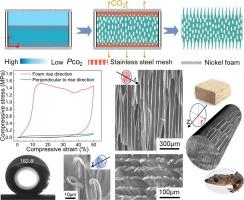通过多约束单向发泡实现增强吸能和超疏水性的双仿生泡沫
IF 13.2
1区 工程技术
Q1 ENGINEERING, CHEMICAL
引用次数: 0
摘要
受基材的各向异性细胞结构和壁虎脚趾的set -spatulate结构的启发,我们设计了双仿生泡沫,采用超临界二氧化碳作为发泡剂,通过巧妙的多约束单向发泡(MCUF)方法,具有高度定向的内部细胞结构和类似set的仿生表面。通过整合周向和表面约束,双仿生泡沫被调节成单向生长,形成高度排列的细胞,长径比为 ~ 18。通过模拟受约束表面网格的微观结构和拉伸聚合物尖端的自发粘弹性收缩,双仿生泡沫在MCUF过程中同时构建了类似seta的表面微观结构。与传统的基于弯曲的变形机制不同,双仿生泡沫的基于细胞壁膨胀的冲击响应机制显著提高了抗压强度,并具有特殊的渐进折叠变形机制,从而导致冲击时的高能量耗散。仿生表面具有双重入微观结构,具有优异的超疏水性,水接触角为 ~ 163°。这些泡沫独特的双重功能属性使它们非常适合需要能量吸收和自清洁能力的应用。此外,可扩展的MCUF方法适用于各种热塑性聚合物,拓宽了双仿生多孔材料的潜在应用。本文章由计算机程序翻译,如有差异,请以英文原文为准。

Dual-bionic foam with enhanced energy absorption and superhydrophobicity realized by multiple constrained unidirectional foaming
Inspired by the anisotropic cellular architecture of basal wood and the seta-spatulate formations of gecko toes, we engineer dual-bionic foams featuring a highly oriented interior cellular structure and a seta-like biomimetic surface through an ingenuous multiple constraint unidirectional foaming (MCUF) method using supercritical carbon dioxide as the blowing agent. By integrating circumferential and surface constraints, the dual-bionic foam is regulated to grow unidirectionally forming highly aligned cells with an aspect ratio of ∼ 18. By emulating the microstructure of the constrained surface mesh and the spontaneous viscoelastic contraction of the stretched polymer tips, the dual-bionic foam simultaneously constructs seta-like surface microstructures in the MCUF process. Unlike conventional bending-based deformation mechanism, the cell wall bulking-based impact response mechanism of dual-bionic foam results in a significant enhancement in compressive strength and a special progressive folding deformation mechanism, which leads to a high energy dissipation upon impact. The biomimetic surface features a double re-entrant microstructure, bestowing exceptional superhydrophobic properties with a water contact angle of ∼ 163°. The unique dual-functional attributes of these foams make them highly suitable for applications requiring both energy absorption and self-cleaning capabilities. Moreover, the scalable MCUF method is adaptable to various thermoplastic polymers, broadening the potential applications of dual-bionic porous materials.
求助全文
通过发布文献求助,成功后即可免费获取论文全文。
去求助
来源期刊

Chemical Engineering Journal
工程技术-工程:化工
CiteScore
21.70
自引率
9.30%
发文量
6781
审稿时长
2.4 months
期刊介绍:
The Chemical Engineering Journal is an international research journal that invites contributions of original and novel fundamental research. It aims to provide an international platform for presenting original fundamental research, interpretative reviews, and discussions on new developments in chemical engineering. The journal welcomes papers that describe novel theory and its practical application, as well as those that demonstrate the transfer of techniques from other disciplines. It also welcomes reports on carefully conducted experimental work that is soundly interpreted. The main focus of the journal is on original and rigorous research results that have broad significance. The Catalysis section within the Chemical Engineering Journal focuses specifically on Experimental and Theoretical studies in the fields of heterogeneous catalysis, molecular catalysis, and biocatalysis. These studies have industrial impact on various sectors such as chemicals, energy, materials, foods, healthcare, and environmental protection.
 求助内容:
求助内容: 应助结果提醒方式:
应助结果提醒方式:


